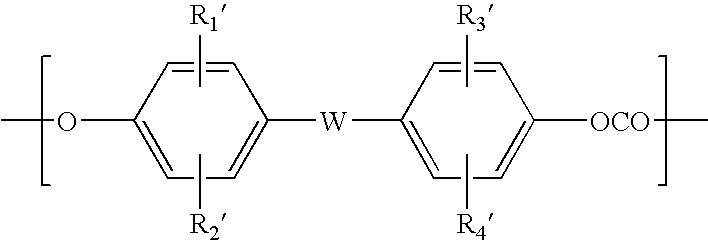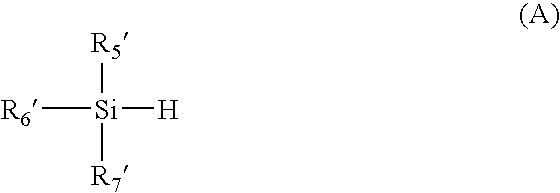Organic Silicon-Based Compound And Method Of Producing The Same
a technology of organic silicon and compound, which is applied in the field of organic silicon compound, can solve the problems that the amount of polycarbonate typically included in the molding of lubricants, adhesives and the like at high temperatures is not necessarily sufficient, and achieves the effects of suppressing the generation of gel, preventing thermal degradation, and preventing coloration
- Summary
- Abstract
- Description
- Claims
- Application Information
AI Technical Summary
Benefits of technology
Problems solved by technology
Method used
Image
Examples
example 1
[Production of 1,1,3,3-tetrakis(2-methoxyphenyl)disiloxane (Hereinafter, Referred to as Compound 1)]
[0216] Into a four-necked flask (i) was charged 3,6 g of magnesium, 50 ml of tetrahydrofuran and a small amount of bromine under nitrogen flow, and mixed liquid of 25 g of 2-bromoanisole and 50 ml of tetrahydrofuran was dropped while stirring. After completion of dropping, the mixture was thermally insulated at 70° C. for 3 hours. The resultant reaction mixture was dropped into a mixture of 9 g of trichlorosilane and 50 ml of tetrahydrofuran charged in a four-necked flask (ii) under ice cooling. After completion of dropping, the mixture was stirred for 18 hours at room temperature.
[0217] The resultant reaction mixture was washed with saturated saline three times, then, the organic phase was dried over anhydrous magnesium sulfate, then, magnesium sulfate was filtrated off. From the resultant filtrate, a solvent was distilled off. The residue after distillation was re-crystallized fro...
example 2
[Production of 1,1,3,3-tetrakis(2-methylphenyl)disiloxane (Hereinafter, Referred to as Compound 2)]
[0219] Into a four-necked flask (iii) was charged 6.8 g of trichlorosilane and 50 ml of tetrahydrofuran. In to the mixture, 100 ml of a tetrahydrofuran solution of o-tolylmagnesium bromide (containing 1.0 mmol of o-tolylmagnesium bromide per 1 ml) was dropped at 0° C. under nitrogen flow. After completion of dropping, the mixture was stirred at room temperature for 5 hours. After completion of stirring, 50 g of water and 100 g of toluene were added, and the mixture was thermally insulated at 113° C. for 5 hours. After completion of thermal insulation, 30 g of 1N-hydrochloric acid was added, and the mixture was allowed to stand at room temperature overnight. After standing overnight, the solution was heated up to 111° C. and thermally insulated for 1 hour at the same temperature. Then, the solution was washed with saturated saline, then, the resulting organic phase was dried over anhyd...
example 3
[0222] [Production of 1,1,3,3-tetrakis(2-methyl-4-methoxyphenyl)disiloxane (Hereinafter, Referred to as Compound 3)]
[0223] Into a four-necked flask (iv) was charged 1,6 g of magnesium, 50 ml of tetrahydrofuran and a small amount of bromine under nitrogen flow. Then, mixed liquid of 12 g of 2-bromo-5-methoxytoluene and 50 ml of tetrahydrofuran was dropped while stirring. After completion of dropping, the mixture was thermally insulated at 70° C. for 2 hours. A mixture of 3.2 g of trichlorosilane and 50 ml of tetrahydrofuran was charged into a four-necked flask (v), and into this mixture was dropped at −30° C. the above-mentioned reaction solution thermally insulated for 2 hours. After completion of dropping, the mixture was stirred for 1 hour at room temperature. Into the resultant reaction mixture was dropped saturated saline at −30° C., and after completion of dropping, the mixture was stirred at room temperature for 12 hours. The resultant organic phase washed with saturated salin...
PUM
| Property | Measurement | Unit |
|---|---|---|
| temperature | aaaaa | aaaaa |
| temperature | aaaaa | aaaaa |
| temperature | aaaaa | aaaaa |
Abstract
Description
Claims
Application Information
 Login to View More
Login to View More - R&D
- Intellectual Property
- Life Sciences
- Materials
- Tech Scout
- Unparalleled Data Quality
- Higher Quality Content
- 60% Fewer Hallucinations
Browse by: Latest US Patents, China's latest patents, Technical Efficacy Thesaurus, Application Domain, Technology Topic, Popular Technical Reports.
© 2025 PatSnap. All rights reserved.Legal|Privacy policy|Modern Slavery Act Transparency Statement|Sitemap|About US| Contact US: help@patsnap.com



